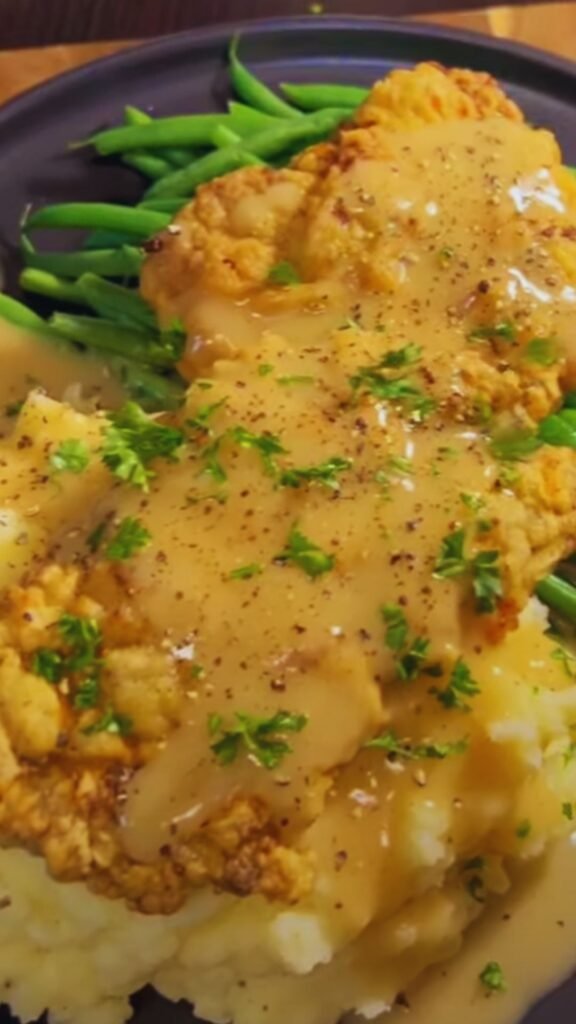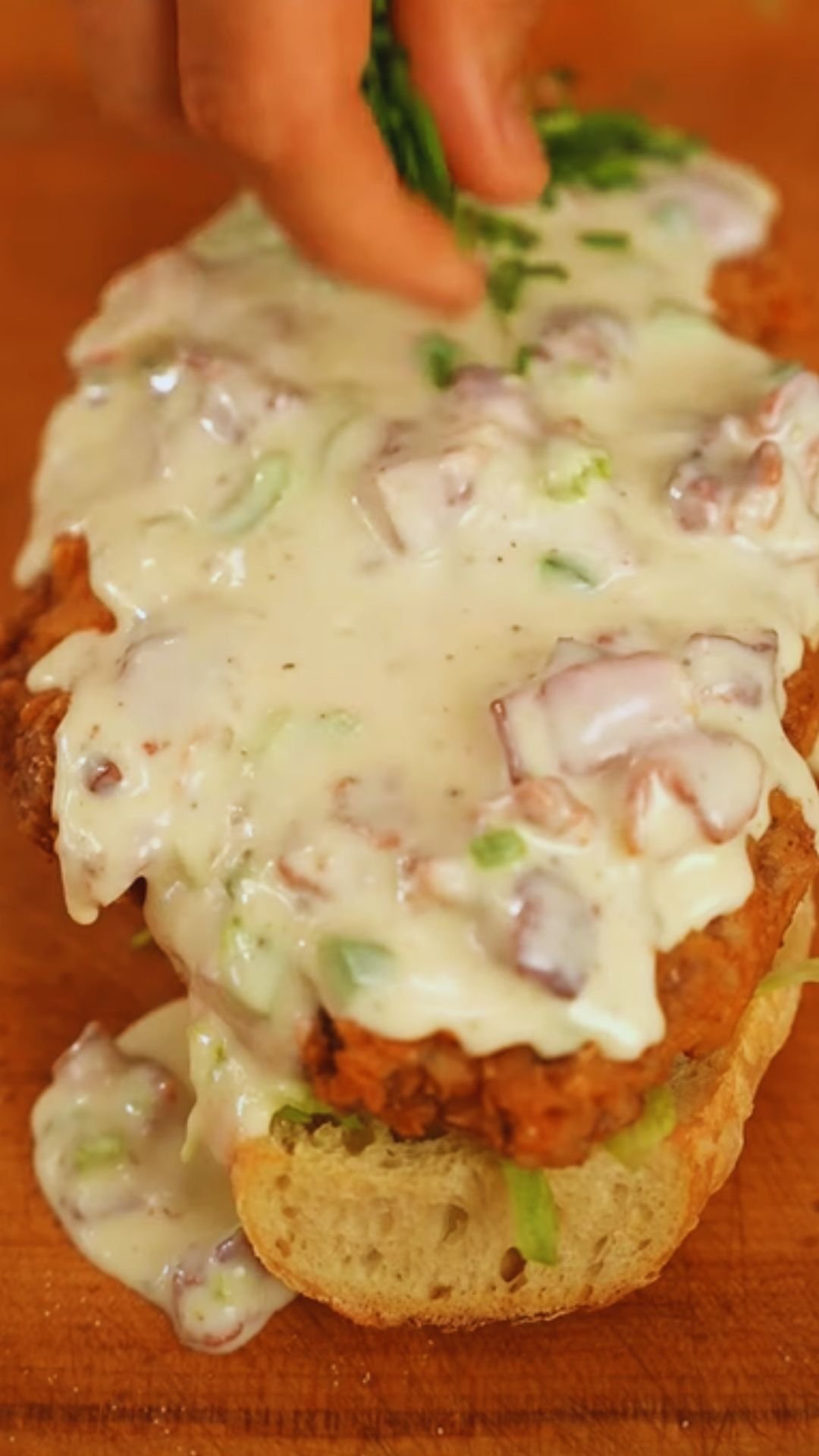There’s something magical about that first bite of a perfectly prepared chicken fried steak—the satisfying crunch of the golden crust giving way to tender, juicy beef, all smothered in creamy, peppery gravy. As someone who’s spent years perfecting this classic comfort food, I’m excited to share everything I know about creating restaurant-quality chicken fried steak right in your own kitchen.
The History Behind the Plate
Despite its name, chicken fried steak contains no chicken at all. This beloved dish earned its moniker from the cooking method—the steak is prepared similarly to fried chicken, with a seasoned flour coating and deep frying until golden brown. The dish has deep roots in Southern and Texan cuisine, with German and Austrian immigrants bringing their wiener schnitzel techniques to the American South in the 19th century.
In Texas, where I first fell in love with this dish, chicken fried steak is practically the unofficial state meal. Each region puts its own spin on the classic, but the fundamentals remain the same: tenderized beef, crispy coating, and rich gravy.
Choosing the Right Cut
The foundation of any great chicken fried steak begins with selecting the right cut of beef. While you might be tempted to splurge on an expensive cut, traditional chicken fried steak actually works best with more affordable options:
- Cube Steak: My go-to choice and the most traditional option. It’s already tenderized by the butcher, saving you time and effort.
- Round Steak: Typically from the rear leg of the cow, this lean cut benefits tremendously from the pounding process.
- Chuck: From the shoulder area, chuck has good marbling that contributes to a flavorful result.
- Top or Bottom Round: These economical cuts transform beautifully when properly tenderized.
The magic of chicken fried steak lies in its ability to turn tougher, less expensive cuts into something extraordinary through the tenderizing process. I’ve found that regardless of which cut you choose, proper tenderizing is non-negotiable.
Essential Equipment
Before diving into preparation, gather these kitchen tools for the best results:
- Meat Mallet: The star player in achieving tender meat. The textured side breaks down tough fibers.
- Cast Iron Skillet: Provides even heat distribution and excellent temperature retention.
- Deep Fry/Candy Thermometer: For monitoring oil temperature.
- Heavy Bottomed Pot or Dutch Oven: If deep frying instead of pan frying.
- Tongs: For safely handling the steaks while frying.
- Paper Towels: For draining excess oil.
- Wire Rack: Placing fried steaks on a rack rather than directly on paper towels keeps the coating crispy.

The Perfect Chicken Fried Steak Recipe
After countless attempts and refinements, I’ve developed this foolproof recipe that delivers restaurant-quality results every time.
Ingredients
For the Steak:
- 4 (4-6 oz) cube steaks (or round steaks, tenderized)
- 2 cups all-purpose flour
- 2 tsp baking powder
- 1 tsp baking soda
- 1 tsp black pepper
- 1 tsp garlic powder
- 1 tsp onion powder
- 1 tsp paprika
- 1/2 tsp cayenne pepper (adjust to taste)
- 2 tsp salt
- 2 large eggs
- 1 cup buttermilk
- 1/4 cup milk
- Vegetable oil or shortening for frying (enough to reach 1/2 inch depth in skillet)
For the Gravy:
- 1/4 cup reserved oil from frying
- 1/3 cup all-purpose flour
- 3 cups whole milk
- 1/2 tsp garlic powder
- Salt and freshly ground black pepper to taste
The Tenderizing Process
If you’re starting with round steak rather than pre-tenderized cube steak, proper tenderizing is crucial:
- Place the steak between two sheets of plastic wrap or inside a large resealable plastic bag.
- Using the textured side of the meat mallet, pound the meat working from the center outward.
- Flip and repeat on the other side, aiming for a thickness of about 1/4 inch.
- Use a fork to pierce the meat all over, creating additional pathways for the seasoning to penetrate.
I’ve found that taking my time with this step pays huge dividends in the final texture of the meat. There’s something therapeutic about the process, and the results are undeniable—meat that melts in your mouth rather than requiring excessive chewing.
The Breading Station
Setting up a proper breading station streamlines the coating process:
- Station 1: Mix flour with baking powder, baking soda, and all dry seasonings in a shallow dish.
- Station 2: Whisk together eggs, buttermilk, and milk in another shallow dish.
- Station 3: Reserve about 1 cup of the seasoned flour mixture in a third dish for the final coating.
The secret to that beautifully thick, craggy crust is double-dipping:
- Season each piece of tenderized meat with salt and pepper.
- Dredge in the first flour mixture, shaking off excess.
- Dip into the egg mixture, allowing excess to drip off.
- Dredge again in the reserved flour mixture, pressing gently to adhere.
- Place on a wire rack and let rest for 10-15 minutes (this helps the coating stick during frying).
The Frying Technique
Achieving that perfect golden crust requires careful temperature control:
- Heat oil in a cast iron skillet to 350°F (175°C). The oil should be about 1/2 inch deep.
- Carefully place the breaded steaks into the hot oil without overcrowding (fry in batches if necessary).
- Cook for 3-4 minutes per side until golden brown and crispy.
- Transfer to a wire rack placed over a baking sheet, not directly onto paper towels (this keeps the bottom crispy).
- Keep warm in a 200°F (95°C) oven while preparing the gravy.
The ideal temperature range is crucial—too hot and the coating burns before the meat cooks; too cool and the breading absorbs too much oil, becoming soggy. After years of practice, I can almost tell by the sound of the sizzle, but I still recommend using a thermometer for consistent results.
The Creamiest Country Gravy
No chicken fried steak is complete without a blanket of peppery country gravy:
- Pour off all but 1/4 cup of the frying oil, keeping the browned bits (fond) in the pan.
- Return the skillet to medium heat and whisk in the flour to make a roux.
- Cook the roux for 1-2 minutes until it’s light golden brown, whisking constantly.
- Gradually whisk in the milk, stirring continuously to prevent lumps.
- Bring to a simmer and cook for 5-7 minutes until thickened.
- Season with garlic powder, salt, and plenty of freshly ground black pepper.
The gravy should coat the back of a spoon but still flow smoothly—if it’s too thick, whisk in a little more milk; if too thin, simmer longer.

Troubleshooting Common Issues
Even experienced cooks encounter challenges with chicken fried steak. Here are solutions to the most common problems:
| Problem | Cause | Solution |
|---|---|---|
| Coating falls off during frying | Oil not hot enough or coating not adhered properly | Ensure oil is at 350°F and let breaded meat rest 10-15 minutes before frying |
| Tough, chewy meat | Insufficient tenderizing or overcooking | Pound meat thinner and monitor cooking time closely |
| Soggy crust | Draining on paper towels or oil temperature too low | Drain on wire rack and maintain proper oil temperature |
| Lumpy gravy | Adding milk too quickly or insufficient whisking | Whisk constantly and add milk gradually |
| Bland gravy | Underseasoning | Be generous with black pepper and taste as you go |
| Greasy result | Oil not hot enough | Maintain proper oil temperature throughout cooking |
Regional Variations
One thing I love about chicken fried steak is how it has evolved across different regions of the South:
| Region | Characteristic | Gravy Style | Typical Sides |
|---|---|---|---|
| Texas | Larger portions, more pepper in coating | Cream gravy with lots of black pepper | Mashed potatoes, green beans, Texas toast |
| Oklahoma | Similar to Texas but often uses cube steak exclusively | Cream gravy, sometimes with bits of sausage | Mashed potatoes, okra, biscuits |
| Arkansas | Thinner crust, sometimes double-dipped in egg wash | Slightly thinner cream gravy | Mashed potatoes, butter beans, cornbread |
| Louisiana | May include Cajun seasonings in the flour | Gravy sometimes includes a hint of heat or herbs | Dirty rice, collard greens, biscuits |
| Missouri | Thicker crust with more seasoning | Creamier, thicker gravy | Potatoes, corn, dinner rolls |
My personal preference leans toward the Texas style—I love that peppery crust and thick gravy that’s almost white in color, but I’ve enjoyed fantastic versions across the South.
Perfect Pairings: Sides and Serving Suggestions
Chicken fried steak forms the centerpiece of a classic comfort food meal. Here are my favorite accompaniments:
- Mashed Potatoes: The ultimate gravy vehicle. For best results, use Yukon Gold potatoes and add plenty of butter and cream.
- Green Beans: Traditionally cooked Southern-style with bacon, though simple steamed beans provide a nice fresh contrast.
- Buttermilk Biscuits: Perfect for sopping up extra gravy. Make them from scratch for the best experience.
- Creamed Corn: The sweetness balances the savory steak and gravy beautifully.
- Collard Greens: Their slight bitterness cuts through the richness of the other components.
- Fried Okra: Adding another crispy element to the meal.
- Sweet Tea: The classic Southern beverage accompaniment.
For a complete experience, serve family-style on a large platter with sides in separate bowls, allowing everyone to create their ideal plate.

Healthier Adaptations
Traditional chicken fried steak is undeniably an indulgence, but I’ve experimented with lighter versions that maintain the spirit of the dish:
| Traditional Method | Healthier Alternative | Impact on Flavor/Texture |
|---|---|---|
| Deep frying | Air frying at 400°F for 8 minutes, flipping halfway | Slightly less crispy but still satisfying |
| Whole milk and cream | 2% milk or half-and-half | Minor difference in richness |
| White flour coating | Half whole wheat flour, half white flour | Slightly nuttier flavor, still crispy |
| Beef cube steak | Tenderized turkey cutlets | Lighter flavor, still takes the coating well |
| Full-fat buttermilk | Mixture of low-fat yogurt and milk | Tanginess remains intact |
| Salt-heavy seasoning | Herb-forward seasoning blend with less salt | Different but flavorful profile |
While these adaptations won’t produce an identical result to the classic version, they can satisfy a craving with fewer calories and less fat when needed.
Make-Ahead and Storage Tips
Chicken fried steak is best enjoyed fresh from the skillet, but these tips can help with planning and leftovers:
- Prepare ahead: Tenderize and bread the steaks, then refrigerate on a wire rack for up to 4 hours before frying.
- Store leftovers: Refrigerate separately from gravy in airtight containers for up to 3 days.
- Reheat steaks: Place on a wire rack over a baking sheet in a 350°F oven for 10-15 minutes.
- Reheat gravy: Warm slowly on the stovetop, whisking occasionally and adding a splash of milk if needed.
- Freeze: Cooked steaks can be frozen without gravy for up to 1 month. Thaw in refrigerator before reheating.
I find that while nothing beats freshly made chicken fried steak, reheating in the oven rather than microwave helps maintain some of the textural contrast between crispy exterior and tender interior.
Frequently Asked Questions
After sharing this recipe with friends and family over the years, these are the questions I’m most commonly asked:
Q: Why is it called chicken fried steak if there’s no chicken in it? The name refers to the cooking technique, which is similar to Southern fried chicken. The steak is prepared with the same breading and frying method traditionally used for chicken.
Q: Can I use any type of steak for this recipe? While you technically could use any cut, tougher, cheaper cuts like round steak or cube steak work best because the tenderizing process breaks down the tough fibers. Premium steaks would be wasted in this preparation.
Q: What’s the difference between country fried steak and chicken fried steak? Country fried steak typically has a brown gravy and sometimes a lighter breading, while chicken fried steak has a crispy coating and white cream gravy. The terms are often used interchangeably depending on the region.
Q: Why does my breading fall off during frying? This usually happens when the oil isn’t hot enough, or the breaded meat hasn’t rested before frying. Let the breaded steaks sit for 10-15 minutes before frying, and make sure your oil is at 350°F.
Q: Can I make chicken fried steak in an air fryer? Yes! Preheat the air fryer to 400°F, spray the breaded steaks with oil, and cook for about 8 minutes, flipping halfway through. The results won’t be identical to deep-fried, but they’ll still be delicious.
Q: How do I know when the oil is hot enough without a thermometer? Drop a small pinch of flour into the oil—if it sizzles immediately and begins to brown, the oil is ready. If it burns quickly, the oil is too hot.
Q: Why is my gravy lumpy? Lumps form when flour isn’t fully incorporated into the fat before adding milk. Whisk the flour thoroughly into the oil to form a smooth roux, and add the milk gradually while continuously whisking.
Q: Can I make chicken fried steak without eggs? Yes, you can substitute the egg mixture with buttermilk or a mixture of milk and mustard. The coating won’t be quite as substantial but will still be tasty.
A Final Personal Note
My journey with chicken fried steak began in my grandmother’s kitchen in rural Texas. I remember watching her hands work the meat with the tenderizer, the rhythmic pounding a signal that comfort food was on its way. She never measured ingredients, just added “a little of this and a little of that” until everything looked and smelled right.
Years later, in my own kitchen, I’ve tried to capture that same intuitive approach while adding a few techniques I’ve picked up along the way. The recipe I’ve shared here represents not just a method for preparing a dish but a connection to culinary traditions passed down through generations.
Whether you’re making chicken fried steak for the first time or looking to perfect your existing recipe, remember that at its heart, this dish is about transformation—turning humble ingredients into something special through care and technique. That’s the true magic of comfort food.
So heat up that cast iron skillet, give those steaks a good pounding, and prepare to create a meal that satisfies both body and soul. In our fast-paced world, dishes like chicken fried steak remind us to slow down and appreciate the simple pleasures of a home-cooked meal made with love and attention to detail.


